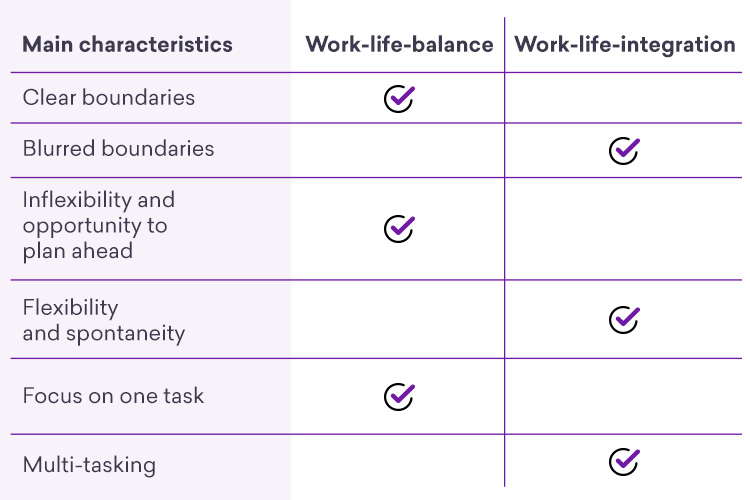Living in the spirit of work-life balance
Work-life balance is a binary approach where you separate your private and professional life, and prioritize them equally. Advocates of this approach try not to bring work home. The moment they close the office door, either literally or metaphorically (when working remotely), they put on hold their work-related commitments and leave all unfinished business until the next working day. The same applies to their private life, which is kept separate from the professional space. In this way, they are able to commit fully to their work without being distracted by private matters.
Main rules of work-life integration
Work-life integration is essentially the opposite of the concept described above. The approach involves the blurring of the boundaries between the private and professional spheres and their seamless integration. According to the concept, busy employees can find a compromise between both these domains instead of viewing them as isolated entities. The compromise will be different from person to person, but it can, for instance, involve doing household chores while participating in a conference call with co-workers or completing another assignment in a personal development course. Another illustrative example is bringing the child to work when schools are closed.
Work-life balance or work-life integration? Which alternative is better?
Each of us is different. We have different sets of commitments as well as distinct priorities and life philosophies. Consequently, there’s no ideal one-size-fits-all way of dealing with all responsibilities. However, it’s possible to point out the advantages and disadvantages of both approaches. Employees should decide for themselves which of the concepts is better suited to their personal situation: type of work and lifestyle factors.

Pros and cons of the work-life-integration approach
The main advantage of work-life integration is definitely flexibility. Employees who are free to make their own choices about how they go about their responsibilities and schedules are said to be more likely to feel fulfilled on many levels. By pursuing work-life integration, they simply have more control over all areas of their lives.
However, there’s also the other side of the coin. Research shows that incompetent blurring of the line between work and private life may have negative effects such as lower productivity and motivation, resulting in less satisfaction in both areas.
Pros and cons of the work-life-balance approach
Work-life balance is a concept with many advantages but not without drawbacks. A key element of the approach is a fixed working-time schedule, which is good for planning well ahead. Any work tasks that are not fulfilled are carried forward to the next day. In theory, the approach helps employees disconnect from work during their free time. Work-life balance is a concept allowing work and life to coexist within clearly defined time frames, the goal being to achieve fulfillment in each of these two core domains.
Unfortunately, theory is one thing and reality another. Nowadays, when remote work is growing fast, it may be extremely challenging to set crystal-clear boundaries between work and home. What’s more, the approach is rather inflexible, which may not always work in practice because of various circumstances beyond our control. In some situations, uncompromising adherence to the concept of work-life balance may be unnecessarily disruptive, for example when just a few extra working hours might be very helpful to wind up a project. Similarly, when an employee has a new child or moves house, they may need to devote more time to family life.

How do you choose the right method for your Team?
When making a choice, the key thing is to have a very thorough look at each employee’s working style. The goal is to determine what contributes to and what prevents effective performance of work assignments.
Work-life balance is likely to be a better option for those who get easily derailed by distractions at work and find it hard to refocus on the task at hand. By pursuing this approach, it’s possible to set detailed schedules for both realms of life to ensure that all commitments are met on time and to the required quality standards. The strategy prevents ambiguity and deficiencies in tackling work and home responsibilities. The approach may work well for those who appreciate clear-cut boundaries, precise deadlines, accuracy and order.
However, some people find it hard to stay productive when working within rigid time constraints and have difficulty concentrating on one assignment for long periods of time. Such employees often need constant mental stimulation and diversity of tasks to stay productive. At the same time, they find it easy to work on several tasks simultaneously, switching back and forth. In such cases, work-life integration may prove to be the perfect solution. It helps to stay fully focused and bolsters motivation and creativity at work. By integrating work and life, such employees have the chance to carve out time for breaks and various assignments, while keeping their productivity high.
How do you put the chosen approach into practice?
The key prerequisite for implementing the chosen concept is support from the employer. Allowing employees to do their work at their preferred time and format is essential to achieving work-life integration. Similarly, a clearly defined working schedule and set of tasks and commitments will help employees achieve a balance between professional and private life. The latter model can be supported by all kinds of mindfulness practice focusing on the ‘here and now’, such as the mindfulness course.
For the employees, on the other hand, it’s important to set boundaries. They should communicate clearly that they won’t be available outside their working hours, as they will devote their free time to personal matters. Employees should be encouraged to engage in such open conversations about their needs, which ultimately improves the efficiency of the entire organization.
The key thing to remember is that the chosen model is supposed to benefit the well-being of the employee but also the company as a whole. However, it shouldn’t lead to conflicts, add responsibilities or be frustrating to employees. The underlying goal is to improve daily functioning by reducing stress levels (with MultiLife’s well-being services contributing to the process), enhancing productivity, and delivering benefits to every member of the Team.
................
References:
1. https://iaap-journals.onlinelibrary.wiley.com/doi/10.1111/apps.12335 - Work and home boundary violations during the COVID-19 pandemic: The role of segmentation preferences and unfinished tasks, Katja Kerman, Christian Korunka, Sara Tement, Appiliet Psychology 2021.
2. https://www.businessnewsdaily.com/5244-improve-work-life-balance-today.html - How to Improve Your Work-Life Balance Today, Marisa Sanfilippo, Business News Daily.
3. https://www.atlantis-press.com/proceedings/sores-18/55915337 - Millennials Engagement: Work-Life Balance VS Work-Life Integration, Muhammad Rizky Afif, SoRes 2018.

